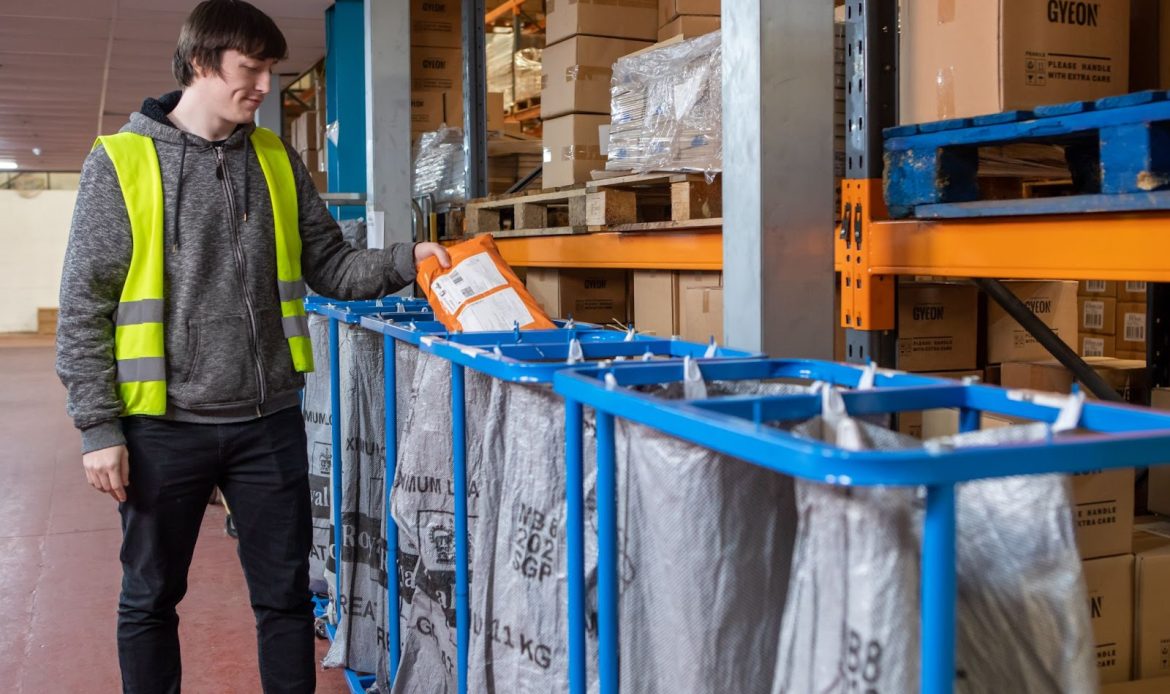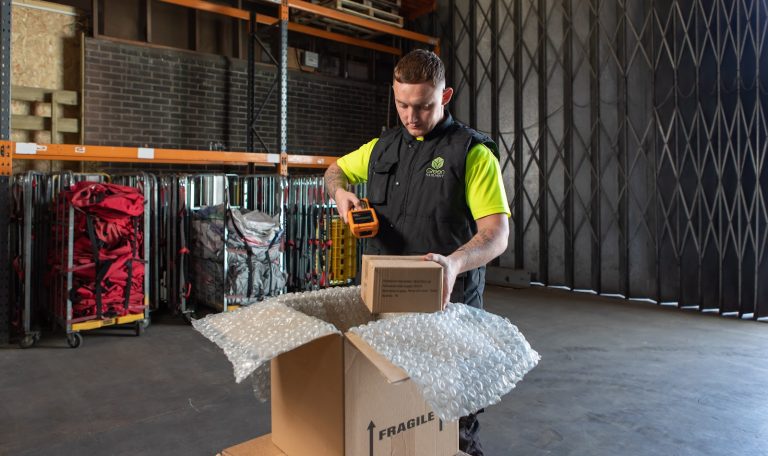Article summary
- Micro-fulfilment centres are small urban warehouses (3,000–10,000 sq ft) for faster delivery
- Last-mile emissions drop with closer inventory and electric vehicle use
- Hidden costs: high energy use and constant restocking from central warehouses
- Limited inventory forces split orders and duplicated packaging
- Strategic hubs offer comparable sustainability with better scale and flexibility
- MFCs need 500+ daily orders in dense areas to justify costs
- Initial investment: £500k–£2m+ with high break-even thresholds
- Most brands (500–5,000 monthly orders) do better with regional hubs
- Hybrid model: regional hubs plus targeted urban MFCs for top products
- Real sustainability needs renewable energy, efficient automation, and smart strategy
UK consumers expect next-day delivery as standard. Two-hour delivery windows are becoming the norm in major cities. Same-day fulfilment isn’t a luxury anymore: it’s table stakes.
This pressure has given rise to micro-fulfilment centres: small, highly automated warehouses tucked into urban spaces, designed to slash last-mile delivery times and cut transport emissions. Retailers from Tesco to Waitrose are investing millions. Logistics experts are calling it the future of sustainable eCommerce fulfilment.
But is it? The reality is more complicated than the headlines suggest.
What Is Micro-Fulfilment?
A micro-fulfilment centre (MFC) is a compact, automated warehouse typically between 3,000 and 10,000 square feet, located in or near urban areas to enable rapid delivery.
How It Works
Instead of relying on distant regional warehouses, retailers position inventory closer to customers, often in converted retail spaces, car parks, or dedicated urban facilities.
Key characteristics:
- Robotics and automated storage systems
- Curated selection of high-velocity products
- Urban or suburban locations
- Same-day or next-day delivery capability
Common product categories include groceries, health and beauty items, fashion basics, and consumer electronics.
The model has gained traction in dense cities where delivery speed matters and transport emissions face scrutiny. London, Manchester, and Birmingham have all seen micro-fulfilment centre deployments over the past three years.

The Sustainability Promise: Why Micro-Fulfilment Looks Green
Micro-fulfilment centres are marketed as environmentally friendly because they reduce last-mile delivery distances. The logic is straightforward: shorter journeys mean lower emissions.
The Environmental Case
1. Reduced last-mile emissions
Last-mile delivery accounts for roughly 41% of total logistics emissions. Positioning inventory five miles from customers instead of fifty should cut transport-related carbon substantially.
2. Electric vehicle compatibility
Shorter delivery routes suit electric vans and cargo bikes. Some micro-fulfilment operations in London now use only electric vehicles for final deliveries, paired with cycle couriers for ultra-local drops.
3. Lower packaging waste
Faster inventory turnover reduces the need for heavy protective packaging. Local operations make returns processing simpler and quicker.
4. Concentrated delivery zones
Dense urban delivery areas enable route optimisation and fewer miles per parcel.
These benefits are real, but they’re only part of the equation.
The Hidden Environmental Costs
Energy Intensity and Automation
Micro-fulfilment centres require constant power for operations that larger warehouses handle more efficiently.
Energy demands include:
- Robotics and conveyor systems running 24/7
- Climate control for temperature-sensitive products
- Computing systems and real-time inventory management
- Continuous lighting in windowless facilities
A 5,000 square foot automated MFC can consume more energy per order processed than a comparable section of a larger warehouse. Scale matters. Larger facilities distribute energy costs across higher volumes, reducing per-unit impact.
Urban areas often lack access to renewable energy infrastructure, meaning reliance on grid power with higher carbon intensity.
The Replenishment Problem
Micro-fulfilment centres don’t eliminate the need for large warehouses: they add to them.
The hidden transport layer:
- Goods move from the supplier to the central warehouse
- Stock transfers to micro-centre (often daily)
- Final delivery to the customer
Each transfer point adds handling, energy, and potential emissions. In some cases, the total transport footprint exceeds what a well-optimised regional hub network achieves.
Limited Inventory Creates Split Fulfilment
Micro warehousing excels at handling fast-moving SKUs but struggles with inventory breadth.
Typical constraints:
- 500 to 2,000 products vs 20,000+ at regional hubs
- Customers ordering slower-moving items still need fulfilment from the main warehouses
- Partial orders require multiple shipments
- Duplicated packaging and frustrated customers
This split fulfilment creates inefficiencies that negate many of the promised benefits.
Strategic Hub Networks Mean Sustainability at Scale
Larger fulfilment centres positioned in strategic locations can achieve similar sustainability outcomes without the constraints of micro-fulfilment.
The Hub Advantage
Regional hubs in locations like Venlo (Netherlands), Swindon, and Glasgow can cover the UK and EU efficiently while maintaining:
- Inventory breadth – Full product catalogues available
- Automation benefits – Economies of scale on technology investment
- Energy efficiency – Better per-unit consumption
- Renewable energy adoption – Solar panels and green energy contracts are viable at scale
Delivery performance:
- UK-wide next-day delivery from three to four strategically placed hubs
- EU delivery within one to two days from well-positioned centres
- B2C and B2B orders fulfilled from the same facility
The carbon savings from reduced lorry miles can match or exceed micro-fulfilment’s last-mile reductions, especially when factored against the MFC’s replenishment needs.
Real Sustainability Features
Larger facilities enable genuine environmental improvements:
- Rooftop solar installations
- Energy recovery systems
- Electric vehicle fleets for regional delivery
- Paperless dispatch systems (saving over 1 million sheets annually in some operations)
- Waste reduction and recycling programmes
- Energy-efficient warehouse design and LED lighting
Sustainable fulfilment at scale also means better returns handling, more efficient kitting and bundling, and value-add services that micro-centres can’t accommodate.

When Does Micro-Fulfilment Make Environmental Sense?
Micro-fulfilment centres aren’t inherently flawed: they’re contextual. The model works best under specific conditions.
Ideal Conditions for MFCs
- High order density
Urban areas with thousands of daily orders from concentrated postcodes justify the investment and operational costs. - Predictable demand
Fast-moving grocery items, everyday health and beauty products, and subscription essentials suit the limited SKU model. - Renewable energy access
Cities with green grid power or on-site renewable generation reduce the energy penalty. - Electric last-mile infrastructure
Urban delivery zones with charging networks and cycle courier services maximise the sustainability upside. - Retail integration
Stores converted to dual-purpose retail and fulfilment spaces (dark stores) can optimise property costs.
Where Hub Networks Outperform
Outside dense urban centres, hub-based networks typically achieve better results:
- Lower-density suburbs and rural areas
- Brands with broad product catalogues (1,000+ SKUs)
- Seasonal businesses with fluctuating demand
- Operations requiring extensive value-added services
- Markets where renewable energy access is better outside city centres
The Financial and Carbon Reality
Investment Requirements
Micro-fulfilment centres carry significant upfront and ongoing costs:
Initial investment: £500,000 to £2 million+ depending on automation level and location
Operating costs:
- Urban rent premiums
- Higher energy consumption
- Specialised labour for automated systems
- Frequent restocking logistics
Break-even threshold: Typically 500+ daily orders from a tight delivery zone, volumes many brands struggle to sustain.
Energy Price Sensitivity
Energy price fluctuations hit micro-fulfilment centres harder than larger facilities. A 20% increase in electricity costs can make an MFC unprofitable while barely affecting a regional hub’s margins.
Carbon Payback Period
Initial embodied carbon from building conversions, automation installation, and infrastructure upgrades often takes years to offset through reduced delivery emissions, if it’s offset at all.
A Hybrid Approach for Growing Brands
The choice isn’t binary. Some retailers use regional hubs for inventory breadth and stability, with targeted micro-locations for high-velocity items in dense urban markets.
Making Strategic Decisions
Questions to ask:
- What percentage of our SKUs generate 80% of orders?
- Do we have sufficient order density in specific urban zones?
- Can we access renewable energy at potential MFC locations?
- What’s our total carbon footprint, including replenishment logistics?
- How will this model scale as we grow?
Brands scaling from 500 to 5,000 orders monthly need fulfilment partners that can grow with them, without requiring infrastructure overhauls at each volume milestone.
Strategic hub networks offer this flexibility. Inventory can expand, new channels can be added, and international expansion becomes possible without the constraints of urban micro-sites.
The Future: Technology, Policy, and Practical Solutions
Emerging Trends
Technology developments:
- More energy-efficient robotics
- AI-driven inventory optimisation reduces waste
- Battery storage enabling renewable energy use
Policy shifts:
- Extended Producer Responsibility regulations
- Clean Air Zones affecting urban delivery
- Green building requirements for new facilities
Consumer behaviour:
- Growing acceptance of longer delivery windows for sustainability
- Willingness to consolidate orders to reduce packaging
The 5-Year Outlook
Micro-fulfilment will likely remain a niche solution for specific use cases: grocery retailers in dense cities, ultra-fast delivery services, and brands with highly concentrated customer bases.
For most eCommerce businesses, strategic hub networks will continue to offer better economics, greater flexibility, and comparable sustainability outcomes when properly optimised.
The brands that succeed will be those making data-driven decisions about where speed genuinely matters, where sustainability improvements create real impact, and how fulfilment infrastructure can scale without compromising either goal.

Making the Right Choice for Your Brand
Micro-fulfilment offers genuine benefits for high-density urban operations, but it’s not a universal sustainability solution. Most growing eCommerce brands achieve better results with strategic hub networks that deliver comparable speed and environmental performance alongside greater flexibility and lower risk.
The key is matching your fulfilment strategy to your actual needs: order volumes, product range, customer geography, and growth trajectory. Brands shipping 500 to 5,000 orders monthly need partners who understand both the technology and the tradeoffs.
Fulfilment centres positioned strategically across the UK and EU can provide next-day delivery, genuine sustainability credentials, and the scalability to support long-term growth, without the operational constraints of urban micro-sites. Real-time inventory visibility, paperless operations, and renewable energy adoption at scale create environmental benefits that match micro-fulfilment’s promises while maintaining the flexibility to handle diverse product ranges and international expansion.
Evaluating your fulfilment options? Compare how strategic hub networks and micro-fulfilment models align with your sustainability goals and growth plans. Get a fulfilment quote to see which approach makes sense for your business.
Frequently Asked Questions
What are micro-fulfilment centres?
Micro-fulfilment centres are small automated warehouses (typically 3,000 to 10,000 sq ft) located in urban areas to enable faster delivery. They use robotics to handle high-demand products for same-day or next-day delivery.
How big are micro-fulfilment centres?
Most micro-fulfilment centres range from 3,000 to 10,000 square feet, though some grocery-focused operations reach 15,000 sq ft. This is significantly smaller than traditional fulfilment centres, which typically span 100,000+ square feet.
What is the difference between micro-fulfilment and dark store?
A dark store is a retail space converted entirely for online order fulfilment with no customer access. A micro-fulfilment centre may operate within or alongside a functioning retail store, or as a standalone automated facility. Dark stores are specific to retail conversion; micro-fulfilment is a broader strategy.
What is an example of micro logistics?
Micro logistics typically refers to small-scale, localised operations. An example would be a grocery retailer operating a 5,000 sq ft automated facility in central London to fulfil online orders within a 3-mile radius using electric vehicles and cargo bikes.
Is micro-fulfilment more sustainable than traditional warehousing?
Not automatically. Micro-fulfilment can reduce last-mile transport emissions, but often increases building energy consumption and requires frequent restocking from central warehouses. The net environmental impact depends on renewable energy access, order volumes, product types, and how efficiently the broader logistics network operates.
Can small eCommerce businesses benefit from micro-fulfilment?
Micro-fulfilment typically requires high order volumes (500+ daily) from concentrated areas to justify costs. Smaller businesses often achieve better results through partnerships with established 3PLs that provide distributed fulfilment networks without requiring dedicated micro-centre investment.




